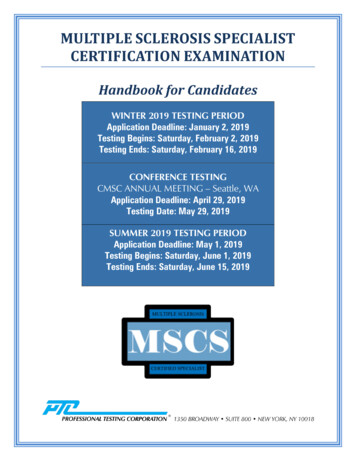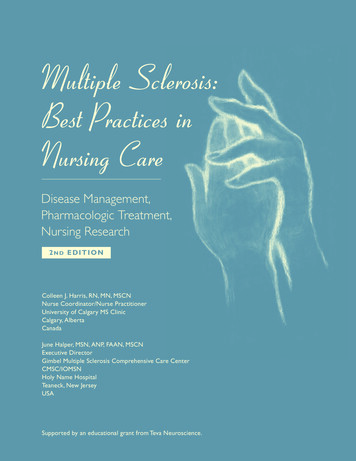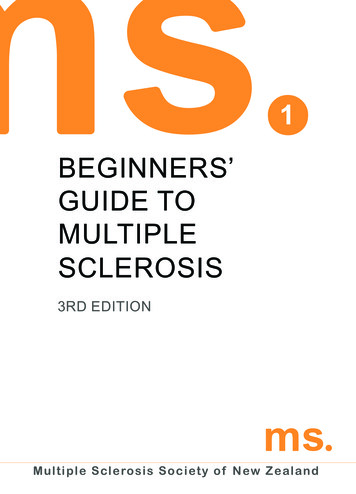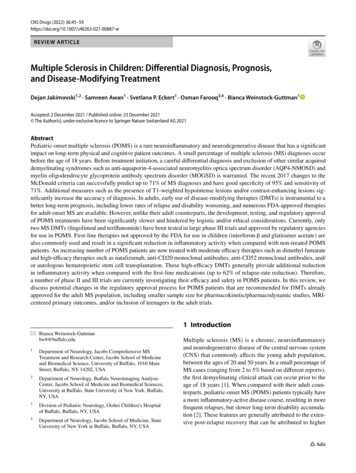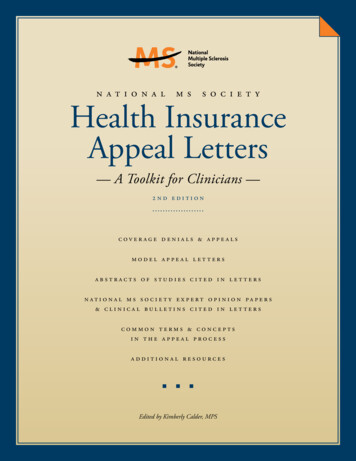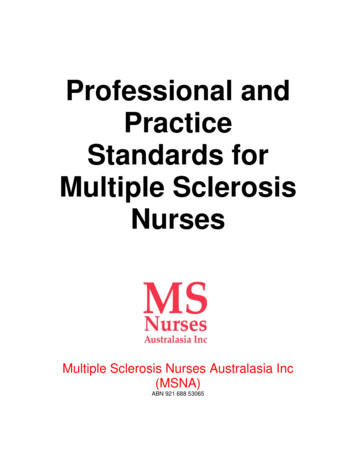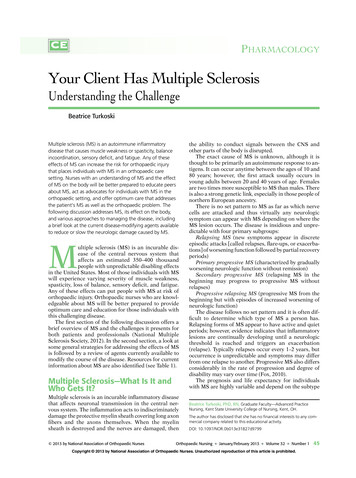
Transcription
PHARMACOLOGYYour Client Has Multiple SclerosisUnderstanding the ChallengeBeatrice TurkoskiMultiple sclerosis (MS) is an autoimmune inflammatorydisease that causes muscle weakness or spasticity, balanceincoordination, sensory deficit, and fatigue. Any of theseeffects of MS can increase the risk for orthopaedic injurythat places individuals with MS in an orthopaedic caresetting. Nurses with an understanding of MS and the effectof MS on the body will be better prepared to educate peersabout MS, act as advocates for individuals with MS in theorthopaedic setting, and offer optimum care that addressesthe patient's MS as well as the orthopaedic problem. Thefollowing discussion addresses MS, its effect on the body,and various approaches to managing the disease, includinga brief look at the current disease-modifying agents availableto reduce or slow the neurologic damage caused by MS.Multiple sclerosis (MS) is an incurable disease of the central nervous system thataffects an estimated 350–400 thousandpeople with unpredictable disabling effectsin the United States. Most of those individuals with MSwill experience varying severity of muscle weakness,spasticity, loss of balance, sensory deficit, and fatigue.Any of these effects can put people with MS at risk oforthopaedic injury. Orthopaedic nurses who are knowledgeable about MS will be better prepared to provideoptimum care and education for those individuals withthis challenging disease.The first section of the following discussion offers abrief overview of MS and the challenges it presents forboth patients and professionals (National MultipleSclerosis Society, 2012). In the second section, a look atsome general strategies for addressing the effects of MSis followed by a review of agents currently available tomodify the course of the disease. Resources for currentinformation about MS are also identified (see Table 1).Multiple Sclerosis—What Is It andWho Gets It?Multiple sclerosis is an incurable inflammatory diseasethat affects neuronal transmission in the central nervous system. The inflammation acts to indiscriminatelydamage the protective myelin sheath covering long axonfibers and the axons themselves. When the myelinsheath is destroyed and the nerves are damaged, then 2013 by National Association of Orthopaedic Nursesthe ability to conduct signals between the CNS andother parts of the body is disrupted.The exact cause of MS is unknown, although it isthought to be primarily an autoimmune response to antigens. It can occur anytime between the ages of 10 and80 years; however, the first attack usually occurs inyoung adults between 20 and 40 years of age. Femalesare two times more susceptible to MS than males. Thereis also a strong genetic link, especially in those people ofnorthern European ancestry.There is no set pattern to MS as far as which nervecells are attacked and thus virtually any neurologicsymptom can appear with MS depending on where theMS lesion occurs. The disease is insidious and unpredictable with four primary subgroups:Relapsing MS (new symptoms appear in discreteepisodic attacks [called relapses, flare-ups, or exacerbations] of worsening function followed by partial recoveryperiods)Primary progressive MS (characterized by graduallyworsening neurologic function without remission)Secondary progressive MS (relapsing MS in thebeginning may progress to progressive MS withoutrelapses)Progressive relapsing MS (progressive MS from thebeginning but with episodes of increased worsening ofneurologic function)The disease follows no set pattern and it is often difficult to determine which type of MS a person has.Relapsing forms of MS appear to have active and quietperiods; however, evidence indicates that inflammatorylesions are continually developing until a neurologicthreshold is reached and triggers an exacerbation(relapse). Typically relapses occur every 1–2 years, butoccurrence is unpredictable and symptoms may differfrom one relapse to another. Progressive MS also differsconsiderably in the rate of progression and degree ofdisability may vary over time (Fox, 2010).The prognosis and life expectancy for individualswith MS are highly variable and depend on the subtypeBeatrice Turkoski, PhD, RN, Graduate Faculty—Advanced PracticeNursing, Kent State University College of Nursing, Kent, OH.The author has disclosed that she has no financial interests to any commercial company related to this educational activity.DOI: 10.1097/NOR.0b013e31827d9799Orthopaedic Nursing January/February 2013 Volume 32 Number 145Copyright 2013 by National Association of Orthopaedic Nurses. Unauthorized reproduction of this article is prohibited.NOR200360.indd 4518/01/13 12:34 AM
impaired balance, and numbness or loss of sensationthat may affect mobility and physical activity. Boweland bladder problems, speech and swallowing problems, and cognition problems are also common effectsof disrupted axonal transmission.The type of symptoms that occur is determined by thelocation of the nerve damage. Lesions in the cerebrumand cerebellum can cause balance, speech coordinationproblems, and tremors. Lesions in the motor nerve tractsare responsible for muscle weakness, spasticity, paralysis, vision problems, and bowel or bladder problems.Lesions in sensory nerve tracts may cause loss of sensation (numbness) or sensations of prickling or burning.TABLE 1. SOURCES OF INFORMATION ABOUT MULTIPLESCLEROSISNational Multiple Sclerosis Society - http://www.nationalmssociety.org Disease Management Consensus Statement about use ofcurrent disease-modifying agents (.pdf) Recommendations Regarding the Use of Cannabis inMultiple Sclerosis (.pdf) Assessment and Management of Cognitive Impairment inMultiple Sclerosis (.pdf) Changing Therapy in Relapsing Multiple Sclerosis:Considerations and Recommendations (.pdf) Rehabilitation: Recommendations for Persons with MultipleSclerosis (.pdf)Diagnosing Multiple Sclerosis Management of MS-Related Fatigue (.pdf) Recommendations Regarding Corticosteroids in theManagement of Multiple Sclerosis (.pdf) Nurse's Quick Reference (A guide to nursing management inMS) (.pdf) Multiple Sclerosis: The Nursing Perspective (.pdf) Multiple Sclerosis: The Nurse Practitioner’s Handbook (.pdf)Multiple Sclerosis Foundation - http://www.msfocus.orgof the disease and the degree of disability the individualexperiences across time. Many individuals with MS areonly mildly or moderately affected. In other cases, overtime the damage may become cumulative and widespread with permanent gradually progressive neurologicdeterioration (Compston & Coles, 2008; Fox, 2010).Signs and Symptoms—The Effectsof MS on the BodyA major challenge in diagnosing MS is that there is noone set pattern of symptoms that all individuals withMS experience. Symptoms are not the same for everyone, anyone with MS can experience any of a wide rangeof neurologic symptoms, and any of these symptomsmay be mild, moderate, or very severe. Early signs andsymptoms of MS can be gradual and relatively benign atfirst or the first attack can be devastating and extremelydebilitating. In addition, the severity of neurologic effects may fluctuate over time and differ greatly betweenone relapse and another.Vision problems (double vision, red-green distortion,blurry vision) are often one of the first symptoms somepeople have of MS. Fatigue is also a very common earlyindication of MS and may often occur when there are noother signs or early indications of disabilities. Multiplesclerosis fatigue is different and is generally more severethan normal fatigue: it can occur in the morning after agood night's rest, tends to worsen throughout the day,may be aggravated by heat and humidity, and may comeon very suddenly. Fatigue is also one of the primary reasons that people with MS leave the workforce.Most individuals with MS experience also some degree of mobility impairment due to either unilateral orbilateral muscle weakness or spasticity in their extremities. Multiple sclerosis can also cause dyscoordination,46Orthopaedic Nursing January/February 2013 Volume 32 Currently, there are no specific set of symptoms or physical findings and no one laboratory test that can, alone,confirm a diagnosis of MS. However, many times a careful medical history and a neurologic examination can beenough for a presumptive diagnosis. A neurologic examination must confirm that (1) there is neurologic evidence of damage in at least two separate areas of theCNS (including the brain, spinal cord, and optic nerves);(2) evidence that the damage occurred at least 1 monthapart; and (3) a fair certainty the damage has no otherreasonable explanation (e.g., exposure to certain toxinscan also cause demyelination).Then, even when there is a family history and clearneurologic evidence, magnetic resonance imaging(MRI) may be used to detect specific areas of demyelination and confirm the diagnoses. An MRI can also differentiate old lesions from those that are new or activeand they are often used to monitor the disease progression. Evoked potential tests, where electrodes are placedon various parts of the head and body, may be used tohelp identify the area where the disruption in nervetransmission is occurring. A spinal Tap may also beused as a part of diagnosis.Treating MSTreatments for MS are aimed at (1) addressing thesymptoms, (2) treating exacerbations, and (3) modifyingthe disease progression.STRATEGIES TO ADDRESS MS EFFECTS ON THE BODYManaging the symptoms of MS is a challenge becausesymptoms vary from individual to individual and mayvary from episode to episode in the same person. Somepeople may experience mild symptoms for the course ofthe lifetime, whereas others may be more seriously affected right from the beginning and may experienceprogressively worsening symptoms. Most symptoms,however, can be managed with lifestyle modifications,assistive devices, physical therapy that focuses on maintaining function, and/or medications that target a specific symptom.A major lifestyle modification for most people withMS involves adjusting their daily activities to addressfatigue (Ayag, 2012). Fatigue affects more than 80% ofpeople with MS and may often occur when there are noNumber 1 2013 by National Association of Orthopaedic NursesCopyright 2013 by National Association of Orthopaedic Nurses. Unauthorized reproduction of this article is prohibited.NOR200360.indd 4618/01/13 12:34 AM
other signs or early indications of disabilities. Multiplesclerosis fatigue is different and is generally more severethan normal fatigue. It can occur in the morning after agood night's rest, tends to worsen throughout the day,may be aggravated by heat and humidity, and may comeon very suddenly. Thus, most individuals with MS willneed to rearrange their entire daily schedule in order topace all activity and ensure adequate rest periods.Gait problems are very common among people withMS. These may be due to muscle weakness or spasticity,balance problems, or severe loss of sensation. Muscleweakness or spasticity may respond to specific targetedexercises or antispasticity medications. However, depending on the degree of disability, gait problems mayrequire the use of mobility aids such as a cane, a walker,or, in extreme cases, a wheelchair.When nerves that control bowel or bladder functionsare affected, dietary changes and appropriate fluid intake may be all that is needed. In some situations, appropriate medications may be used to promote evacuation or facilitate bladder emptying. Swallowingdifficulties may be addressed also with a change in dietand eating patterns or consult with a speech therapist.Most medications used to address the symptoms ofMS are not specific for use with MS. However, there isone medication approved specifically to address symptoms of MS. Dalfampridine (Ampyra) is used to improvewalking speed for individuals with MS who have gaitproblems. It has been shown to help even those who useassistive devices such as a cane or walker. Dalfampridineis a potassium channel blocker that acts to prevent theleakage of potassium from demyelinated axons so thereis less interruption of neuronal signals. It is contraindicated for individuals with a history of seizures or mild tomoderate renal impairment and patients taking dalfampridine should be monitored for adverse effects such asurinary tract infection, dizziness or balance disorder, orrarely, MS relapse (Turkoski, Lance, & Tomsik, 2011).Addressing the effects of MS on the body can differgreatly from person to person. Individuals (and their careproviders) will need to address the changes that occur intheir body. But, for most people with MS, any spontaneity inlife is often no longer possible; constant caution, awareness,and preplanning are necessary to manage the effects of MS.TREATING EXACERBATIONSExacerbations of MS are triggered by an inflammation inthe central nervous system that damages the myelinsheath that protects the nerves. Exacerbations may lastfrom a few days to several weeks or even months and canbe mild or severe. Often they are self-limiting and requireonly symptom management. However, severe exacerbations are treated with high-dose corticosteroids (prednisone or methylprednisolone) to reduce the inflammationand lessen the extent of the axonal damage.DISEASE-MODIFYING AGENTSBefore there were any disease-modifying agents available, there was little that could be done to slow the progression of MS. Up until now there were only eightdisease-modifying agents to treat relapsing forms of MSand only one of these was oral. However, with the recent 2013 by National Association of Orthopaedic NursesFood and Drug Administration approval of teriflunomide (Aubagio) there are now nine, two of which areoral. The Medical Advisory Board of the NationalMultiple Sclerosis Society has recommended that treatment with a disease-modifying agent should start immediately following the diagnosis of a relapsing form ofMS. The Board further recommends that treatmentshould continue indefinitely unless there is clear evidence of no benefit or side effects are intolerable.The currently available disease-modifying drugs arenot designed to make anyone with MS “feel better,” andthey will not cure the disease. Rather, they primarilyfocus on the immune dysfunction and may lessen thefrequency of exacerbations, slow the progression ofrelapsing forms of MS, and reduce the risk of significantdisability. Currently, there is no agent approved fortreating primary progressive disease.The following is a brief overview of the nine diseasemodifying agents currently approved for use with MS.Major cautions, limitations, and side effects are identified (Sandofi, 2012; Turkoski et al., 2011).Beta interferons (first-line therapies): Avonex (interferon beta-1a), Betaseron (interferon beta-1b), Extavia(interferon beta-1b), and Rebif (interferon beta-1a). Action. All of the beta interferon agents act to slowthe accumulation of physical disability and decrease the frequency of clinical exacerbations forpatients who have experienced a first clinical episode and have MRI results consistent with MS.The exact mechanism of how they work to reducefrequency of relapses is unknown. Pregnancy Risk Factor. C. Administration. Avonex: Intramuscular weekly;Betaseron and Extavia: subcutaneous every otherday: Rebif. subcutaneous three times a week. Cautions. Interferons have been associated withsevere psychiatric events (mania, depression, psychosis, and suicidal ideation). They should beavoided in presence of severe psychiatric disorders.Extreme caution and close monitoring are requiredfor persons exhibiting symptoms of depression orseizure disorder. Caution should be used with preexisting cardiovascular, pulmonary, or hepatic impairment. No known interactions with other medication other than a possible increase in levels oftheophylline derivatives or Zidovudine when usedconcurrently with beta interferons. Monitoring. Liver function tests, thyroid function,hematology, and complete blood cell (CBC) countwith differential should be done before administering an interferon and repeated periodicallythroughout treatment. Reactions. Rare anaphylactic reactions have occurred; the patient should be educated about signsand symptoms. Flu-like reactions (sometimes severe) are associated with interferon: the use of analgesics and antipyretics is recommended; thesereactions may lessen over time. Patient education. Not a cure for MS. Appropriateinjection procedure if self-administered. Contactthe prescriber if any severe or prolonged reactions.Orthopaedicrthopaedic Nursing January/February 2013 Volume 32 Number 147Copyright 2013 by National Association of Orthopaedic Nurses. Unauthorized reproduction of this article is prohibited.NOR200360.indd 4718/01/13 12:34 AM
Glatiramer Acetate (Copaxone).Natalizumab. Action. Induces and activates the T-lymphocytesuppressor cells that are specific against the myelin antigens, for example, blocks the autoimmuneattach on myelin. Pregnancy Risk Factor. B. Administration. subcutaneous daily Cautions. Avoid use concurrently with BCG, livevaccines, natalizumab (Tysabri), roflumilast, andtopical tacrolimus. Adverse effects. Immediate postinjection reaction(flushing, chest tightness, dyspnea, palpitations)self-resolving and occurs less often with subsequent injections. Nausea, rash, infection, and flulike symptoms. Patient education. Not a cure for MS. May reduceseverity and incidence of exacerbations. Rotateand monitor injection sites daily. Appropriate injection procedure for self-administration is important to prevent severe skin and tissue damage.May experience postinjection reaction with firstinfection and occasionally with subsequent injections. Contact the prescriber for unusual or prolonged reactions. Action. Monoclonal antibody—interferes with themovement of potentially damaging immune cellsfrom bloodstream to brain and spinal cord. Limitations. Reserved for cases where there hasbeen inadequate response or inability to tolerateany other agent. Patients must be enrolled inTysarbi Care Program. Pregnancy Risk Factor. C. Administration. Intravenous (over 1 hour) every 4weeks. Caution. Not to be used with any other diseasemodifying agent. Increases risk for progressivemultifocal lukoencephalopathy (PML), whichcauses death or severe disability as a result of JCvirus. Prior use of immune suppressing drugs increases the risk of developing PML. Discussionwith patients should review the benefits and risksof PML. Monitoring. Liver enzymes, CSF analysis, MRIscan. Test for antibodies to JC virus prior to therapy. Monitor response every 6 months (TysarbiCare Program). Observe closely during and for 1hour following infusion for hypersensitivity reaction: patients who demonstrate an infusion hypersensitivity reaction should discontinue immediately and not be re-treated. Adverse effects. Infusion reaction. Hepatotoxicity,increased fatigue, visual field defects, anxiety, cognitive changes, aphasia, ataxia, opportunistic infection. Patient education. Not a cure for MS. May experience infusion reaction (you will be monitoredduring and after infusion). Identify possible adverse effects and instruct the client to contact theprescriber if adverse effects are severe or prolonged.Fingolimod (Gilenya). Action. Causes inflammatory cells (lymphocytes)to get trapped in lymph nodes so there are fewerlymphocytes available in the CNS, which reducescentral inflammation and neuron damage. Pregnancy Risk Factor. C. Administration. Oral daily. Cautions. Do not use in presence of acute orchronic infections (may increase risk of infectiondue to reduction of lymphocytes). Use cautionwith concurrent immunosuppressant, immunemodulation, or antineoplastic medications. Usecaution with severe hepatic impairment, historyof diabetes, or uvelitis. Avoid concurrent use withBCG, live vaccines, natalizumab, roflumilast, andtopical tacrolimus. Monitoring. Ophthalmic examination should bedone prior to therapy and 3–4 months after treatment starts (macular swelling). Electrocardigram,CBC, liver enzymes, and bilirubin prior totreatment. CBC periodically during treatment.Evaluate need for varicella vaccine before startingtherapy. Blood pressure throughout therapy.Observe for 6 hours following first dose—severebradycardia may develop. Adverse effects. Immediate postinjection reaction(bradycardia may occur within 1 hour of therapywith maximal decrease occurring 6 hours after thedose). Flu-like symptoms, diarrhea, cough, opportunistic infection, and vision changes. Patient education. Not a cure for MS. May reduceseverity and incidence of exacerbations. Need tohave heart rate monitored for 6 hours followingfirst dose. Explain possible reactions and instruct client tocontact the prescriber if signs of opportunistic infection or if side effects are severe or unusual.48Orthopaedic Nursing January/February 2013 Volume 32 Mitoxantrone (Novantrone).Number 1 Action. A type II topoisomerase inhibitor thatdisrupts DNA synthesis in cells (antineoplasticchemotherapy drug). Limitations. Approved for both secondary progressive and relapsing-remitting MS who have notresponded to first-line agents. Cytotoxic. Total cumulative lifetime dose is limitedaccording to body mass to limit cardiac problems. Pregnancy Risk Factor. D (pregnancy should beruled out before beginning therapy.) Administration. Intravenous every 3 months over2–3 years (until maximum lifetime cumulativedose is reached). Cautions. Myelosuppression (not recommendedin presence of preexisting myelosuppression),myocardial toxicity—(risk increases with cumulative dosing), increases risk of acute myelogenousleukemia, should not be used in presence of hepatic impairment. Desiccant—avoid extravasation(can cause severe tissues damage). Risks of cardiotoxicity should be discussed withthe patient. Monitoring. Pregnancy status (before and duringtreatment); cardiac status (electrocardigram with 2013 by National Association of Orthopaedic NursesCopyright 2013 by National Association of Orthopaedic Nurses. Unauthorized reproduction of this article is prohibited.NOR200360.indd 4818/01/13 12:34 AM
left ventricular ejection fraction) prior to eachdose and at appearance of any cardiac symptoms(individuals with MS should have cardiac monitoring annually following discontinuation oftherapy due to delayed cardiotoxicity); CBC countand liver function tests prior to infusions. Adverse effects. Cardiotoxicity, acute myelogenousleukemia, hypersensitivity reactions, myelosuppression, gastrointestinal upset, hyperglycemia,opportunistic infections, gastrointestinal upset(diarrhea, constipation, nausea, and vomiting),hair lose, mouth sores, and edema. Patient education. Not a cure for MS. Urine,saliva, tears, sweat, and white of eyes may turnblue-green for 24 hours postinfusion. Identifypossible adverse effects and instruct the patient tonotify the prescriber if any effects are severe orprolonged.Teriflunomide (ApprovedSeptember 13, 2012). Action. Teriflunomide is a pyrimidine synthesisinhibitor that acts to reduce the number of activated lymphocytes in the central nervous system. Limitations. Approved for relapsing forms of MS. Pregnancy Risk Factor. Pregnancy contraindicated (pregnancy registry available). Administration. Oral daily–-with or without food. Cautions. Avoid use in presence of hepatic impairment, pregnancy, or serious infection. If necessary,to discontinue may require accelerated elimination procedure (effects may continue for up to2 years). Avoid concurrent use with leflunomide,hormonal contraceptives. Monitoring. Pregnancy (before, during, and for2 years following discontinuation), signs andsymptoms of infection (immunosuppressioneffect), blood pressure, CBC count (prior to therapy), and liver function tests (6 months prior totherapy and at least monthly for 6 months).Monitor INR in concurrent use of warfarin.Monitor response with the concurrent use of drugsmetabolized by CYP2C8 or CYP1A2. Adverse effects. Hepatotoxicity, immunosuppression, alopecia, diarrhea, nausea, paresthesia(peripheral neuropathy that is not related to theMS), hypertension, renal failure, severe skinreaction, hypertension. Patient education. Not a cure for MS. May reduceseverity and incidence of exacerbations. Will needto have laboratory testing on regular basis. Mustavoid pregnancy for up to 2 years following discontinuation (can cause severe harm to fetus)malformation. Explain possible reactions and instruct client to contact the prescriber with signs ofhepatic changes, skin reaction, opportunistic infection, numbness in extremities that is differentfrom symptoms of MS, or if side effects are severeor unusual.The choice of whether or not to use a diseasemodifying medication and the decision about which 2013 by National Association of Orthopaedic Nursesone to use must be a matter for the individual and theirprofessional care provider to make. None of these agentsare curative and none will repair neurologic damagethat has been done. Early use of disease-modifyingagents, however, may reduce the number of relapsesand slow the progress of inflammatory destruction andmay provide individuals with MS considerable moretime without serious disability.ConclusionThe diagnosis of MS is challenging, the efficacy of anycurrent treatment is variable, a cure is nonexistent, andthe symptoms make daily life difficult for the majorityof those who have to live with MS. While some peopleexperience a mild and fairly benign form of MS, othershave a more severe form that causes muscle weaknessor spasticity, balance incoordination, or sensory deficitand fatigue. Any of these effects of MS can increase therisk for an injury that would place them in an orthopaedic care setting.Nurses with knowledge of MS can optimize the quality of care for patients who have MS by developing careprotocols that address the challenges of MS and the effects of MS on the body (Ayag, 2012). One major consideration in care planning is recognizing that, for the individual with MS, a specific daily routine for activity, rest,diet, and elimination is not just a whim or a quirk. Forpatients with MS, intolerance for flexibility or resistance to change in routine is not just stubbornness, butrather it may be the only way these individuals maintainsome control over their symptoms. A nurse can play apivotal role in educating multidisciplinary team members about MS to and advocating to schedule all activities around the goal of preserving patient strength andreducing undue fatigue.Medication education for both peers and patients isanother nursing responsibility. Many professionals arenot well informed about the MS-disease modifyingdrugs and the rationale behind their use. And, individuals with MS who are using one of these medicationsmay benefit from additional teaching and reinforcement for self-administered injection procedures.Whether a patient enters the orthopaedic care areaas a result of MS damage or because of something unrelated to the MS, the nurses who understand MS willbe invaluable. Having MS is, for most people, a constant challenge and having caregivers who areunderstanding and knowledgeable about MS will notonly optimize care but will also lessen the patient'sanxiety and fear.REFERENCESAyag, A. (2012). Nurses quick reference: Caring for patientswith multiple sclerosis. National Multiple SclerosisSociety. Retrieved July, 2012, from mpston, A., & Coles, A. (2008, October). Multiple sclerosis. Lancet, 372(9648), 1502–1517.Fox, R. J. (2010). Multiple sclerosis. Cleveland Clinic Centerfor Continuing Education, Center for DiseaseOrthopaedicrthopaedic Nursing January/February 2013 Volume 32 Number 149Copyright 2013 by National Association of Orthopaedic Nurses. Unauthorized reproduction of this article is prohibited.NOR200360.indd 4918/01/13 12:34 AM
Management. Retrieved June 20, 2012, from seasemanagement/neurology/multiple sclerosis/National Multiple Sclerosis Society. (2012). About MS.Retrieved June 2012 from http://www.nationalmssociety.orgSandofi. (2012). Augagio: Highlights of prescribing information. Retrieved September 14, 2012, from ski, B., Lance, B., & Tomsik, E. (2011). DrugInformation handbook for advanced practice nursing.Hudson, OH: Lexi Comp.For 58 additional continuing nursing education articles on neurologicaltopics, go to nursingcenter.com/ceCALENDERNational OfferingsMay 18-21, 2013–NAON 33rd AnnualCongress, Strong Values, Strength inPractice., San Antonio, TX.Regional OfferingsSeptember 30, 2012—NAON’sOrthopaedic Nursing ComprehensiveReview Course. Presented by CatholicHealth, Appletree Business Park, Ste8A2875 Union Road, Cheektowaga,NY 14227. For more information:50Orthopaedic Nursing Conference Center, 5230 CentreAvenue, Pittsburgh, PA 15232.For more information: Mary EllenPritchard, 412-623-2925, orpritchardme@upmc.eduCarol Caputi, 716-706-2541 orccaputi@chsbuffalo.orgFebruary 14, 2013—Peace – Love –Orthopaedics. Presented byNortheast Wisconsin Chapter.Comfort Suites, 1951 Bond Street,Green Bay, WI 54303. For moreinformation: Sherri Hanrahan,920.858.4683 or sherri.hanrahan@bellincollege.eduFebruary 15, 2013—MC Excellence InOrthopaedic Nursing Symposium.UPMC Shadyside HebermannJanuary/February 2013 Volume 32 Number 1March 7, 2013—NAON OrthopaedicNursing Review Course. Providedby Northern Illinois HealthcareEducation Network. Presence StJoseph Medical Center Joliet, IL.For more information: RosemaryHomer, 630-468-2162 or rmh@halliganlynch.com. 2013 by National Association of Orthopaedic NursesCopyright 2013 by National Association of Orthopaedic Nurses. Unauthorized reproduction of this article is prohibited.NOR200360.indd 5018/01/13 12:34 AM
Multiple Sclerosis (.pdf) † Changing Therapy in Relapsing Multiple Sclerosis: Considerations and Recommendations (.pdf) † Rehabilitation: Recommendations for Persons with Multiple Sclerosis (.pdf) † Management of MS-Related Fatigue (.pdf) † Recommendations Regarding Corticosteroids in the Management of Multiple Sclerosis (.pdf)
